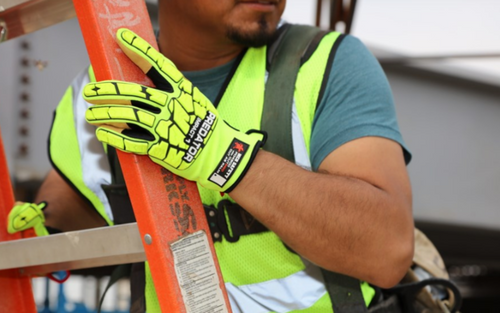Common Work-Related Hand Injuries
Job-related hand injuries are one of the main reasons many workers end up in the emergency room and miss work. These injuries can also have a negative impact on their lives outside of work. It’s crucial to protect your hands by making sure you can safely pick up and interact with tools, equipment, materials, and other items related to your job. If the worker loses control of the object or machine due to a loss of feeling, they could injure themselves and the other people around them. Workers may also use their hands to shield themselves from injury during a fall or when dodging a falling object. These types of workplace hazards can damage the nerves, muscles, and bones in a person’s hands, and may make it difficult for them to continue their work..
Employers are responsible for ensuring that their workers have access to the proper safety gloves and PPE on the job while minimizing their exposure to potential hazards to prevent serious injury as well as muscle aches, sprains, and strains.
Common Types of Hand Injuries
Workers in the construction, utility, and electrical industries may put their hands in harm’s way when operating machinery or interacting with objects in the field. According to the Safety and Health Council of North Carolina, the most common work-related hand injuries include:
- Lacerations and cuts to the skin (63%)
- Crushing of the hand (13%)
- Avulsions or detachments (8%)
- Punctures (6%)
- Bone fractures (5%)
Other potential hazards include electrical and chemical burns, frostbite, penetration, contusions, and milder injuries like muscle pain and stiffness.
Common Causes of Hand Injuries
A laceration to the hand could damage the blood vessels, nerves, and tendons underneath the skin. They are often caused by blunt force trauma to the hand, such as a cut or sudden impact. Workers can easily crush their hands if a heavy object falls on top of it or they put their hands too close to the machine. The improper use of equipment can also damage hand muscles, making it harder for workers to grip objects. Workers may easily lose their grip when operating equipment. Severe weather, including extreme heat and rain, increase the risk of work-related injuries.
There are many situations where these kinds of injuries can occur. The U.S. Bureau of Labor Statistics notes that over 70% of workers experiencing hand injuries were not wearing gloves at the time, and the remaining 30% were not wearing the right type of glove.
How to Prevent Hand Injuries
Knowing how to select safety gloves is one of the best ways to prevent work-related hand injuries. Workers need to use safety gloves designed specifically for the tasks or hazards, such as chemical resistant gloves, heat resistant gloves, cut resistant gloves, and cold weather work gloves. The gloves should also fit properly and come with a reinforced grip to help the person retain control of equipment and machinery. Every person needs to inspect and try on their gloves before starting their shift to ensure they’re not damaged and need repairs or replacement. The glove needs to cover their entire hand and wrist. Ideally, it will overlap with the person’s sleeve to keep the skin on their arms covered. If the glove appears worn or no longer fits, it should be discarded or set aside for repairs. The glove should be heat resistant when working with or around fire and waterproof/weatherproof when working in the cold or rain.
Employers should also inspect the workplace for potential hazards and do everything they can to eliminate these risks as much as possible before sending staff into the field. This may include changing the location of the worksite, setting up safety guards, and providing shelter in extreme weather.
Workers should be fully trained on how to use various pieces of equipment so they don’t injure themselves in the process. They should always keep their hands away from the mechanical part of the machine, including belts, blades, compactors, fans, turbines, and other moving components.
There’s also a chance the machine could start when the person least expects it. Machines should also be locked out when not in use, so they don’t accidentally turn on when workers have their hands inside the machine. Devices that could penetrate a person’s hand, such as power tools and drills, should also be unplugged when they aren’t being used.
Workers should also use the proper lifting techniques when handling or moving objects to reduce the risk of injury. This may include using a forklift instead of lifting objects by hand and storing sharp objects or potentially hazardous products in the proper container.
Everyone needs to protect their hands when operating heavy machinery or working in high-risk industries. Contact PK Safety to speak with our safety experts about selecting the best safety glove for your job.
Recent Posts
-
Customizing Gas Detectors: Tailoring Solutions to Fit Your Unique Requirements
In today’s diverse industrial landscape, a one-size-fits-all approach to safety simply doesn’t cu …Jul 3rd 2024 -
10 Ways to Prevent Wildfires
You can prevent wildfires by extinguishing flames before you leave the worksite. Avoid practicing …Jul 1st 2024 -
ANSI/ISEA 138 Safety Gloves: Ensuring Hand Protection
The human hand is an anatomical masterpiece and arguably the greatest tool attached to our bodies …Jun 25th 2024





